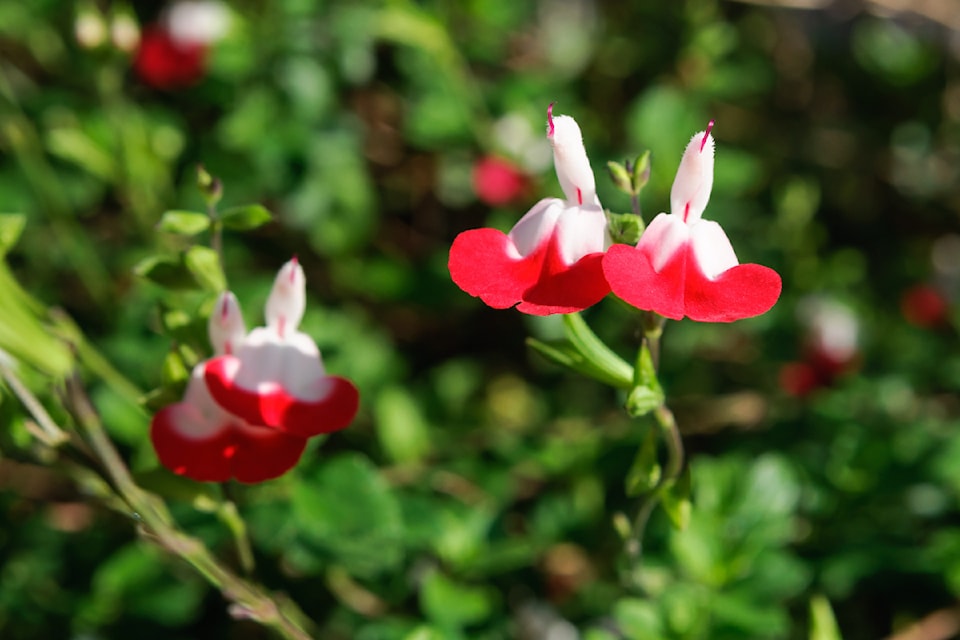BY ELLEN PRESLEY
Special to the Record
Salvia (sage) is the backbone of the garden. There are many varieties: some used medicinally, some ceremonially, some used as flavouring for cooking and other used ornamentally in the garden. They can be perennial or annual.
Salvia officinalis (common sage) is the culinary herb that most people know. It is an evergreen shrub with woody stems, grayish leaves and blue to purple flowers. Great for flavouring such as stews, stuffing for poultry and pork and sausages. Sage is also used in a tea for medicinal purposes.
All salvia prefer full sun, adapt to most soil conditions, and bloom throughout the summer as long as you deadhead. It is deer- and rabbit-resistant, drought-tolerant and attracts many pollinators such as bees, butterflies and hummingbirds to your garden.
For annuals try salvia splendens ‘Sizzler Red.’ It forms a mound of eight inches with bright red spires rising another four inches above the plant creating colourful plumes. It will definitely brighten up a border or container and makes a great cut flower. For a softer look try the award-winning salvia coccinea ‘Summer Pink Jewel’ (4-20”), which has lovely two-lipped tubular shell pink flowers.
Salvia farinacea ‘Victoria Blue’ (18-20”) resembles lavender with its rich violet-blue vertical blooms, which is lovely in the garden or added to containers. Or if you want something taller that will make a bold statement in your garden, try salvia guaranitica ‘Black and Bloom’ which is 3-4 feet tall and wide. A real showstopper with tall black stems and iridescent blue flowers that the hummingbirds will fight over.
Salvia (meadow sage) is one of the longest-blooming perennials. All varieties are deer- and rabbit-resistant, drought-tolerant once established, easy to maintain and attract many types of pollinators. Great for mass planting, filling gaps in your garden or adding splashes of colour to an area - this invaluable perennial is essential to any garden design.
Salvia microphylla ‘Hot Lips’ is eye-catching with brilliant red and white flowers that are lipstick red. Another favourite of hummingbirds, this award-winning variety grows two to four feet tall but is considered a tender perennial Zone 7 so give it some protection in winter.
There are many hardy blue varieties on the market: New Dimension (8-10”), Blue Queen (18-23”) and the popular Caradonna (20-29’), which has unusual dark stems and dark violet -blue flowers that are great in bouquets. Salvia nemorosa ‘Blue Marvel’ is a dwarf meadow sage (10-12”) with stunning spikes of rich violet-blue flowers. It boasts the largest flower of all the nemorosa family and is very hardy at Zone 4.
There are several pink varieties to choose from, such as Sensation medium Deep Rose (12-14“)” which has masses of beautiful rose flowers from spring to fall and is great as a cut flower (Zone 5). Or try the introduction from P.W ‘Back to the Fuchsia’ (22”) with bright fuchsia pink blooms.
We just got a new variety in salvia hybrida ‘Blue by You‘(20-22”) with gorgeous dark purple flower spikes that are loaded with blooms and the bees are loving it. It re-blooms five times during the summer when given a light trim.
Salvia is a must-have in the garden, whether you use it on its own to accent a container or used in mass planting, creating waves of colour. Have fun with it this summer. Happy Gardening!
Ellen Presley is the owner of Anderton Nursery, located at 2012 Anderton Rd., Comox



